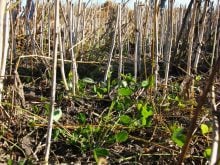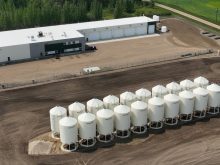On the one hand, Jay Fox, Manitoba Cattle Producers president, is grateful for Manitoba Agriculture staff and the work they’ve done to help cattle farmers around Lake Manitoba deal with near record lake levels and flooded forage land.
But on the other hand, he is frustrated with the Manitoba government because they could have taken steps to prevent the disaster, which is forcing producers to relocate 100,000 head of cattle to higher ground.
“The thing that really gets my goat … is that this didn’t have to be this way. There were some mistakes made on (Manitoba) Water Stewardship’s end,” said Fox, a cattle producer near Eddystone, Man.
Read Also

Feds propose overhaul of chronic wasting disease control program
Chronic Wasting disease control program getting updated by Canadian Food Inspection Agency with feedback encouraged from producers.
“They knew that a lot of water was coming…. In other parts of the province they had dropped lake levels down where they could and they could have done the same with Lake Manitoba. But they chose not to.”
On May 9, the provincial government urged cattle producers near the lake to move their cattle to other pastures in Manitoba, Saskatchewan and Alberta because water levels on the lake were rising faster and higher than anticipated.
The lake is now expected to crest in mid-June at 815.8 feet above sea level, which would be the highest level since 1961, when the province constructed an outlet channel for the lake at Fairford, Man.
Steve Ashton, emergency measures minister, has said Manitobans are coping with a one in 300 year flood of the Assiniboine River. As a result, provincial hydrologists pumped as much water as possible through the Portage Diversion, which channels water from the Assiniboine River into Lake Manitoba.
Farmers and property owners around the lake have said that the lake is rising because inflows from the Portage Diversion have far exceeded the capacity of the lake’s sole outlet, the Fairford River Dam. Since April, the province has channeled 25,000 to 33,000 cubic feet per second of water into the lake and released 10,000 to 14,000 through the Fairford structure.
Yet, the province insists the rising lake levels and the associated flooding of low-lying land around Lake Manitoba is a natural, not a manmade disaster.
“I really want to stress that this is a natural flood,” Ashton said May 19.
“If people are saying this is a serious flood, they’re right. But it’s very much driven by natural conditions.”
To back up that statement, a government news release stated if the Portage Diversion and Fairford Dam weren’t in place, the water levels in Lake Manitoba would be 1.1 feet higher.
“If you look at the net inflow and the net outflow, that tells you what would’ve been the natural level of the lake,” Ashton said. “If you take out any of the inflows of the Portage Diversion, you take out Fairford structure… lake levels would’ve been higher today.”
Jay Doering, University of Manitoba civil engineering professor, said the key factor in this debate on whether high lake levels are a manmade disaster or not is the Portage Diversion.
“The question that has to be asked here… is how much has the additional water that’s being put down the Portage Diversion, raised the level of Lake Manitoba?”
Steve Topping, Manitoba Water Stewardship executive director, said the province hasn’t completed the calculations to determine the Portage Diversion’s contribution to lake levels.
But Doering suspects that people around Lake Manitoba are overestimating the impact of the Portage Diversion.
“I don’t think that it’s going to add up to feet (of water on the lake). I honestly don’t,” he said. “I think, primarily, the water level we’re seeing is runoff from the natural watershed of Lake Manitoba.”
Regarding Fox’s point that the province should have lowered lake levels in preparation for the spring flood, Ashton said the government must manage the lake according to regulations. In 2005 the Lake Manitoba Regulation Review Advisory Committee helped develop operating rules that keep lake levels between 810.5 to 812.5 feet above sea level. Furthermore, ice on the lake limits how much water the province can release via the Fairford outlet, Topping said.
Ashton said the province released as much water as it could through the Fairford outlet to manage lake levels before the flood.
“We’ve been operating the Fairford year round, according to the operating rules, in a way that’s safe and minimizes impacts downstream,” he said. “But that doesn’t mean someone had a switch, that he could have used, to press a button and lower the water.”
A LOOK AT LAKE LEVELS
Provincial officials have not explained how water flowing from the Assiniboine River into Lake Manitoba via the Portage Diversion contributes to rising water levels on Lake Manitoba, but mathematical calculations can estimate the diversion’s impact on the lake.
The diversion has a capacity of 25,000 ft3/sec., but to minimize flows in the Assiniboine River, provincial hydrologists pumped as much as 33,000 ft3/sec. down the diversion channel in May.
The calculations are based on Manitoba Water Stewardship operating the Portage Diversion and the Fairford River dam at full capacity, on average. In reality, the province is exceeding the capacity of both structures.
Assuming the over-capacity flows at both structures cancel each other out:
•If 25,000 ft3/sec. enters and 10,000 ft3/sec. leaves, the net inflow is 15,000 ft3/sec. into Lake Manitoba.
•This equates to 38.88 billion cubic feet of water per month. The surface area of the lake is 1,785 sq. miles or 49,762,944,000* sq. feet. (*corrected June 3, 2011)
•Thus, the Portage Diversion adds 0.7815 feet (9.4 inches) to lake levels in a month.
Source: Staff research















